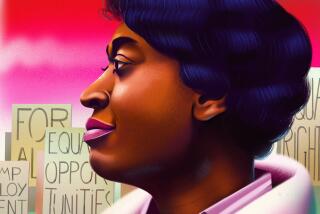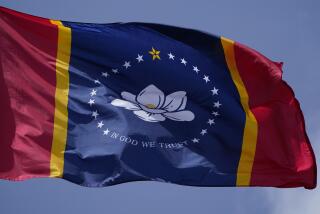Many Know Little of Historic Marches : Blacks Hope to Rekindle Spark of Selma in Youths
- Share via
SELMA, Ala. — Joe T. Smitherman, the long-time mayor and political boss of this tiny rural Alabama city, delights in telling about the time Vanessa Williams paid an official visit here during her ill-starred reign as the first black Miss America.
Like many another visiting VIP--white as well as black--the beauty queen was asked if she would like to be shown Brown Chapel AME Church and the Edmund Pettus Bridge, two historic sites in the tumultuous protest marches that rocked Selma 20 years ago and helped spark passage of the landmark Voting Rights Act of 1965.
The church served as a headquarters for blacks during the demonstrations and was the starting point of the marches; the bridge was the scene of a bloody confrontation between 525 marchers and state troopers and sheriff’s deputies armed with clubs, whips and tear gas.
But, as the mayor tells the story, Williams responded to the invitation with a look of puzzlement. “She had to be told what it was all about,” he said. “She said she knew about Montgomery”--site of the 1955 bus boycott by blacks that propelled Dr. Martin Luther King Jr. to national prominence--”but she didn’t know a thing about Selma.”
Smitherman’s latest retelling of that anecdote--to a reporter here to cover the 20th anniversary commemoration of the historic Selma marches--rankles many black and civil rights leaders gathered here. They say the story has a bad ring coming from a one-time staunch segregationist who two decades ago would not have allowed Vanessa Williams to step foot into his office--except to clean it.
But they find it difficult to deny the basic truth it illuminates: that a disturbing number of the younger generation of black Americans are growing up with little or no knowledge of the events here that dramatically altered the course of the nation’s history.
In fact, the anniversary activities have placed a special emphasis on kindling among youths the torch originally ignited by Selma in that turbulent era.
“Black people, and black youth especially, need to understand that the right to vote was not a gift of our political system but came as a result of blood, sweat and tears, and the exercise of the nonviolent process,” said the Rev. Joseph E. Lowery, president of the Atlanta-based Southern Christian Leadership Conference, one of the organizational sponsors of the anniversary commemoration.
To that end, a daylong series of workshops was conducted Saturday on such subjects as “Youth Leadership to Continue the Struggle in the Field of Voter Registration and Politics” and “The Impact of History and Culture on the Struggle for Civil and Human Rights.”
Prominent blacks, many of them graying veterans of the ‘60s Selma campaign, have been delivering inspirational messages to the younger generation at every opportunity.
Position of Honor
And young people were given an honored position in the reenactment launched Sunday of the historic 50-mile march from Selma to Montgomery, the state capital, led by King two weeks after the “Bloody Sunday” incident at the Pettus bridge.
Black leaders also pledged to continue such efforts as part of a nationwide campaign after the anniversary celebration officially concludes Thursday with a mass rally on the steps of the state Capitol in Montgomery.
“We can’t afford to let the lesson of Selma be lost on the younger generation,” said the Rev. James Orange, a Birmingham minister and union organizer who marched in Selma during the ‘60s. “If you don’t remember your past, you’re doomed to repeat the mistakes.”
Fear of Setbacks
Orange’s words take on even more urgency in these days of widespread alarm among black Americans that the hard-won civil rights gains of two decades ago are under massive assault--especially from Washington, which blacks have long regarded as their most powerful ally in the struggle for full equality.
The causes behind the distressingly low level of knowledge about Selma among young blacks are many.
“Most of these young people were born since 1965,” said Atlanta City Councilman John Lewis, who was only 25 himself when he helped lead the march across the Pettus bridge that ended in the “Bloody Sunday” confrontation. “They’ve never seen any signs saying ‘White Only’ and ‘Colored Only’ and ‘Colored Waiting Room’ and ‘White Waiting Room.’
“They haven’t witnessed the violence that young people witnessed 20 years ago in this town.”
Symbols of Oppression
Moreover, Lewis added: “The issues also were more sharply defined then. And of course we had strong symbols of oppression”--among them, Gov. George C. Wallace, then a virulent racist whose battle cry was “Segregation forever!” and Dallas County Sheriff Jim Clark, a rednecked Southern lawman who sported a lapel pin that said: “Never!”
Also to blame, black leaders say, are the lack of meaningful black history studies in schools--especially integrated institutions--and the absence on the national scene of a figure of the stature of the slain King.
One illustration of the enormity of the educational task ahead was given during one of the Saturday youth workshops.
The 50 or so largely teen-aged youngsters who attended the session included many from Selma and surrounding communities in Alabama’s “Black Belt” who might have been expected to be up on their local history.
Don’t Know History
When asked, however, to name the first black elected to a county office in Dallas County since Reconstruction--a milestone as monumental to blacks in this region as the ‘60’s marches in Selma are to blacks in general--only one youngster ventured a guess, a 13-year-old girl who answered: “Benjamin Banneker.”
She might have gotten an “E” for effort. But oddly enough, she was Sala Walker, daughter of that first elected black official, Jacqueline Walker, who won the county tax assessor’s job in November, 1984, but died in an automobile accident before she could take office.
(Banneker has been described as America’s “first black man of science.” A mathematician and astronomer, he was appointed by President George Washington to the survey team that laid out the boundaries for the District of Columbia.)
To be sure, any group of young people in a similar situation--Jewish youths being quizzed about the Holocaust or Latino youngsters being asked to identify great Hispanic leaders--might turn in a similar performance.
But Selma’s place in history holds a poignant significance for young blacks today because young blacks then played an instrumental part in securing that place.
“I was only 8 years old when I took part in the ‘Bloody Sunday’ march,” recalled Sheyann Webb Christburg, who defied her parents to do so. “I was inspired by King’s words. The excitement and trauma on that bridge is something I will never forget.”
Wrote Own Obituary
Indeed, so fearful was she of her life after that march that she wrote out her own obituary. Now 29 and director of her own public relations firm in Montgomery and co-owner with her husband of a beauty parlor, she credits her present success in life to the civil rights movement of the ‘60s.
“I learned at an early age that if you want to get ahead in life, you have to pay a real hard price,” she said.
That message is one black leaders hope will be hammered home to more and more black youngsters in the months and years ahead.
More to Read
Sign up for Essential California
The most important California stories and recommendations in your inbox every morning.
You may occasionally receive promotional content from the Los Angeles Times.










